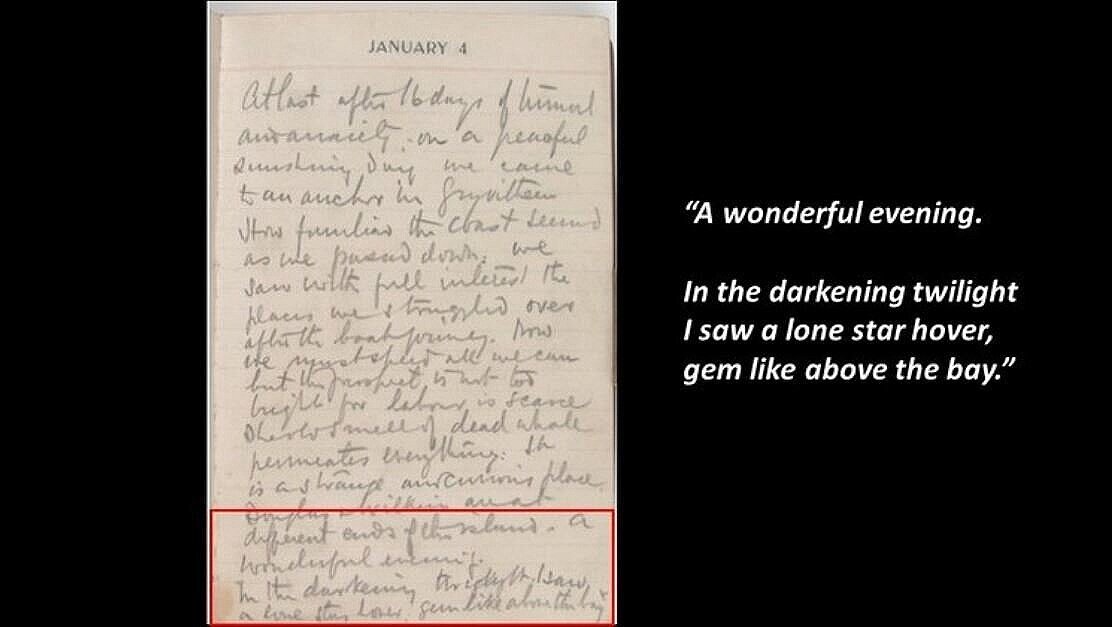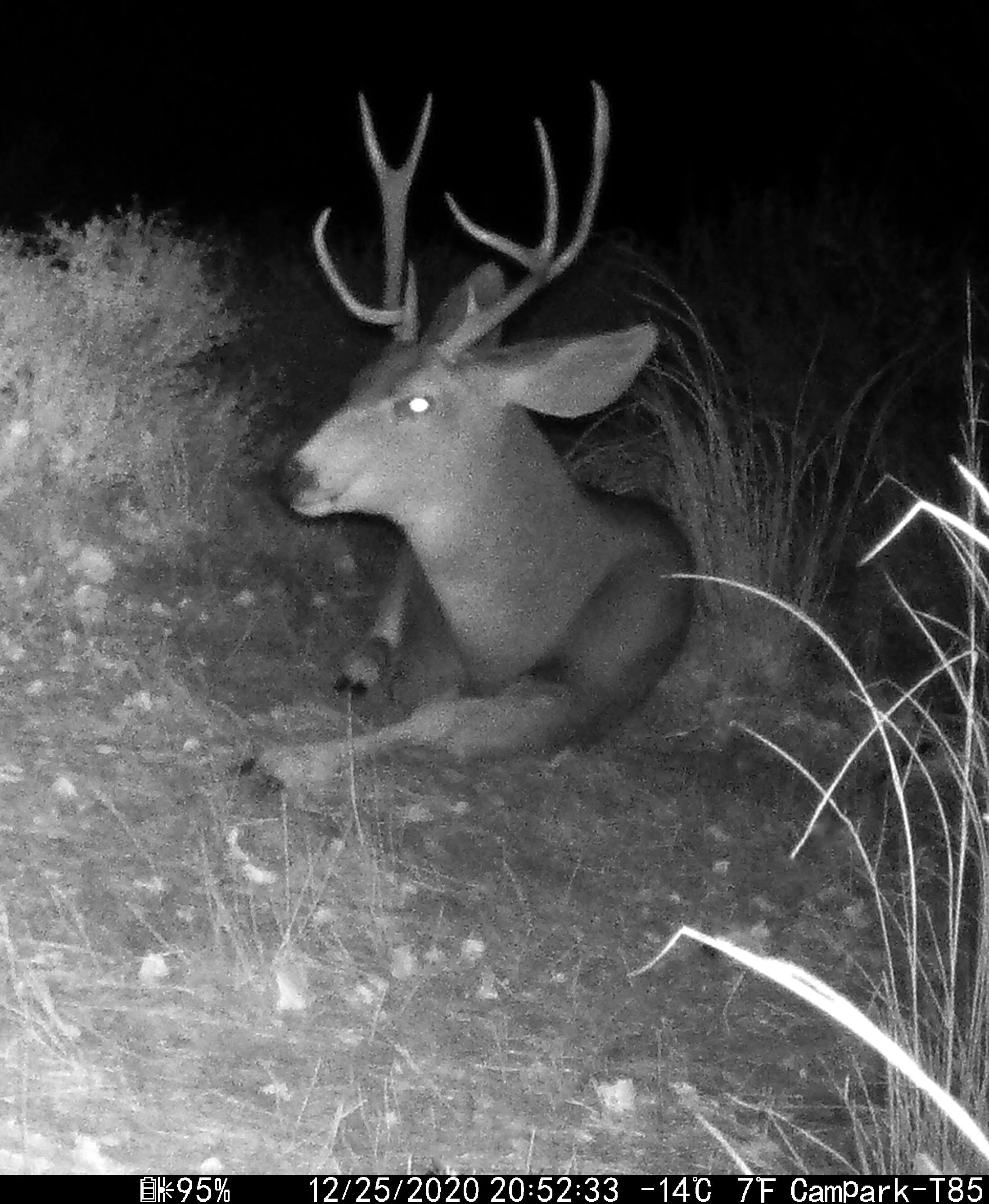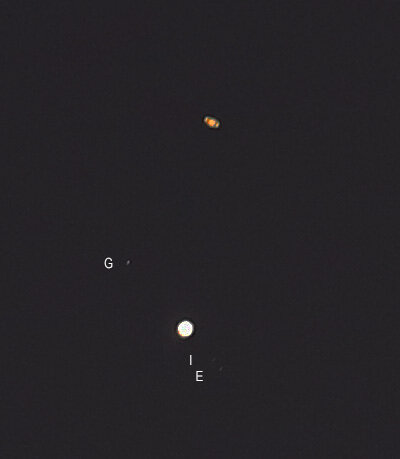forming an illuminated curtain in front of the La Sal Mountains during dawn this morning, with Round Mountain somewhat silhouetted in the foreground.
What if...
Castleton Tower toppled? Perish the thought!
Or, alternatively, another sandstone tower was present atop Baby Carriage Rock, as there almost certainly was in the distant past?
Geometric artwork of hoarfrost...
is sustained in deeply-shaded areas where temperatures never rise above freezing, coupled with a right amount of moisture in the chilled air. The ice crystals comprising the surface hoar that is pictured below are much like icy corn flakes and about the same size.
Venus and Luna rising...
above the high summits in the La Sal Mountains, Utah on this frigid early morning.
Rockfall from Porcupine Rim...
in Castle Valley, Utah occurred around 1 am MST, and was so loud that it woke me up! I stoked the fire in the wood stove and went back to bed, finding the small scar and debris run-out only after sunrise. It’s the geology of now!
Closer view under different lighting conditions.
Debris shed during the small event was funneled into several steep ravines eroded into the mudstone slopes of the Chinle Formation. The vertical Wingate escarpment is about 500 feet high to give a sense of scale. No residential structures were impacted.
Waning crescent moon...
under 8% illumination, three days before the new moon.
A conspiracy of ravens...
Common Raven (Corvus corax).
Sir Ernest Henry Shackleton...
died on this day in 1922 in Grytviken, South Georgia, and is buried in the graveyard just outside the historic and remote whaling station. On the evening before he passed away, after returning to his ship in the harbor - the Quest - he wrote what was to be the final entry in his log book:
Final page from Shackleton’s log book, courtesy of the Scott Polar Institute.
Using the SkySafari planetarium program, entering the location, time and date of that fateful night in Grytviken, this is the starry sky that Shackleton would have witnessed. Sirius and Canopus are the two brightest stars in the night sky, and he was almost certainly writing about one of them.
Sir Ernest Shackleton is one of my great heroes, leading the entire crew of the Endurance to an epic rescue in brutal Antarctic conditions on the ill-fated 1914–1917 Imperial Trans-Antarctic Expedition. I will certainly raise a toast to him today, the 99th anniversary of his death. RIP.
A Western Meadowlark...
joins the seed hunt at the feeding station.
Western Meadowlark (Sturnella neglecta). (Click image to enlarge.)
Birds taking refuge...
in the cedar tree outside my front window, as a Sharp-Shinned Hawk patrols the feeding station.
Dark-eyed Junco keeping a watchful eye.
This sparrow crunches his sunflower seed in the safety of the hide.
This sparrow is chomping on an ice crystal.
December's "Cold Moon"...
setting behind Porcupine Rim early this morning, the last full moon of the year. I get up early so you don’t have to, even in 5 degree F temperatures!
First and only tracks...
after the slow-moving snowstorm that dropped about seven inches on Castle Valley during the last two days.
The view behind, and ahead (seen below), on my afternoon ride. (Click image to enlarge.)
Fat tires rule in these conditions! Where’s everyone else?
Relaxing mule deer...
after assisting Santa’s reindeer on their delivery route in Castle Valley, Utah.
There’s a herd of about 18 of these friendly creatures that regular chill out on my property, less than 10 meters from my door. There’s no hunting allowed in the community, and I don’t have a dog, so this is a quiet place to hang out. They even watch me when I’m out doing my astrophotography thing!
Kane Creek Road...
parallels the south bank of the Colorado River downstream from Moab, Utah, then winds through a narrow, meandering Wingate-walled canyon before ultimately cresting out at Hurrah Pass.
The “Birthing Rock” in the Kane Creek area displays a variety of petroglyphs attributed to the Ute Indians who lived in the area from 1300 AD up to 1880. This image spans an area of about two meters square to give a sense of scale.
End of the ride today at Hurrah Pass, 20 miles out-and-back, with 1,800 feet elevation gain.
Panoramic view from summit of Hurrah Pass, near the crest of the Kane Creek anticline. Look closely and one can spy the solar evaporation pond terraces across the Colorado River. (Click image to enlarge.)
View across Kane Springs Creek from below Hurrah Pass, where the Cutler Formation is exposed in the valley bottom. (Click image to enlarge.)
Kane Creek Road to Hurrah Pass (red) completes a triptych of rides in and around the Intrepid Potash solution mining operation. The green and blue tracks show previous rides in the area on the Potash Road and at Dead Horse Point State Park, respectively.
Gravity happened along Utah 128...
between Moab and Castle Valley sometime today. This part of the Wingate escarpment along the Colorado River had been previously shedding rocks a few months before (on 18 August), but this large rockfall placed enormous sandstone blocks in the river. New obstacles for next year’s river runners.
In speaking with some residents in Castle Valley, the consensus is that this occurred sometime mid-day today, and is not correlated with the small local tremor of the 20th.
The morning after...
the Great Conjunction I was up early and caught a transit of the ISS heading northeastward, above Castleton Tower and the Rectory, where it was eventually lost in the light pollution from Grand Junction, Colorado.
Approximately two minute-long exposure with a tripod-mounted Canon 6D and Rokinon 14 mm lens, f/4, ISO 400.
As close as it gets...
as the orbital dance of the planets in the solar system bring Jupiter and Saturn within 0.1 degrees of one another, at least as viewed by Earthlings on this winter solstice.
The Galilean moons of Callisto, Io and Europa make an appearance during the Great Conjunction of 2020.
Happy holidays...
if it is at all possible during this annus horribilis. At least the days will start getting longer.
Fresh brown bear scat, Kamchatka, 2010.
On the eve of the Great Conjunction...
I bundled up and shot these images as Jupiter and Saturn approach each other for their closest encounter in more than 800 years.
Full frame shot with, serendipitously, a jet contrail catching the setting sun above Porcupine Rim.
Cropped subframe clearly showing Saturn and Jupiter, and the Galilean moons of Ganymede, Io and Europa.
A small temblor...
apparently shook the local region at 2:11 am MST, but the minor earthquake was entirely unnoticed by me, fast asleep in Castle Valley, Utah. But there are in fact 16 “felt” reports at the USGS website. So here’s the technical information about the less-than-eventful event: M 4.3 - 28 km E of La Sal, Utah
Map from the U. S. Geological Survey showing epicenter. Red symbol indicates Castle Valley, Utah.






























